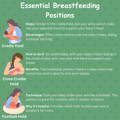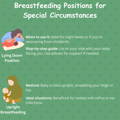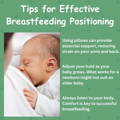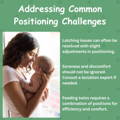A: Newborns often do well with the cradle or cross-cradle hold due to the extra head support these positions provide.
Your cart is empty
Shop formulasYou have not added any favorites yet.
Shop formulasRecommended products
Comfortable Breastfeeding Positions for You and Your Baby
Written by Renee Published on 01/04/2023 Read Time 7 min

Breastfeeding is a unique journey for every mother and baby, filled with its own set of joys and challenges. Finding a comfortable position is crucial not only for effective feeding but also for the well-being of both mother and child. This article delves into various breastfeeding positions, offering practical advice and solutions tailored to different needs and circumstances.
Understanding Breastfeeding Basics
Breastfeeding is more than just a means of nourishment; it's a bonding experience that provides essential nutrients and antibodies to your baby. However, it can come with challenges like latching difficulties and physical discomfort. Understanding these basics sets the stage for a smoother breastfeeding experience.
Essential Breastfeeding Positions
Breastfeeding your baby can be a beautiful and rewarding experience, but it can also be challenging, especially if you're a new mom. One of the things that can make a big difference in your breastfeeding journey is finding the correct position that works for you and your baby. To help you with this, here are three different breastfeeding positions that you might find helpful:
1. Cradle Hold: This is a classic breastfeeding position where you hold your baby in your arm, with their head resting in the crook of your elbow. Use your free hand to support your breast. This position is ideal for full-term babies and promotes a solid emotional connection between you and your baby. It's also a good position if you're recovering from a vaginal birth.
2. Cross-Cradle Hold: This position is similar to the cradle hold, but your arms switch roles. You use your opposite hand to support your baby's head. This position gives you more control over the baby's head, making it easier for them to latch on and feed well. It's a good position if you're having trouble getting your baby to latch.
3. Football Hold: In this position, you tuck your baby under your arm like a football. This position is excellent for mothers with C-section incisions as it relieves incision pain. It also benefits mothers with twins who want to feed both babies simultaneously. This position is perfect for babies who have trouble latching.
Remember, finding the correct breastfeeding position might take some trial and error. Feel free to try different positions until you find the one that works best for you and your baby.

Breastfeeding Positions for Special Circumstances
Breastfeeding can be challenging, especially for mothers and babies with particular circumstances. Using proper breastfeeding positions can help make the process easier and more comfortable.
Lying Down Position
This position is ideal for night feeds or if you're recovering from childbirth. It allows you to rest while feeding your baby. To get into this position, lie on your side with your baby facing you. Ensure your baby's nose is level with your nipple to allow them to latch on properly. If needed, use pillows for support to make yourself comfortable.
Upright Breastfeeding
This position is beneficial for babies with reflux or ear infections. It allows your baby to sit upright while feeding, reducing the amount of regurgitating milk. Hold your baby upright, straddling your thigh or hip to get into this position. Ensure your baby's head is supported and their nose is level with your nipple. This position can be done standing or sitting, and you can use a nursing pillow to make yourself more comfortable.

Tips for Effective Breastfeeding Positioning
Breastfeeding can be tricky, especially when it comes to positioning. But don't let that discourage you - with the proper techniques, you can make it a comfortable and enjoyable experience for you and your baby. Let’s look at some tried-and-true tips to help you effectively position yourself for breastfeeding.
Pillow Positioning
One way to make breastfeeding easier is to use pillows to provide essential support. This will help reduce the strain on your arms and back, making breastfeeding more comfortable and less tiring.
Adjust as Needed
It is important to note that as your baby grows, you should adjust your hold accordingly. What works for a newborn might not be suitable for an older baby. You should experiment with different positions and angles until you find the one that works best for you and your baby.
Comfort is Key
Always listen to your body. Breastfeeding can be physically demanding, and it's essential to prioritize your comfort. If you experience discomfort or pain, try adjusting your position or using different pillows. Remember, comfort is vital to successful breastfeeding, and a happy and relaxed mother is likelier to have a happy and satisfied baby.

Addressing Common Positioning Challenges
We know that breastfeeding can be challenging, and some difficulties are expected along the way. One of the most common problems that breastfeeding mothers face is latching issues. However, it's essential to know that slight positioning adjustments can resolve many latching problems. For example, ensuring that the baby's mouth is wide open, the chin is touching the breast, and the baby's lips are flanged outwards can make a big difference.
It's also important to remember that experiencing soreness or discomfort while breastfeeding is not normal and should not be ignored. If you feel any pain or discomfort while breastfeeding, it's crucial to consult a lactation expert as soon as possible. A lactation expert can help you identify the problem's root cause and advise on how to address it.
If you're a mother of twins, you may find it challenging to breastfeed both babies efficiently and comfortably. In such a situation, it's essential to know that feeding twins requires a combination of positions. For example, you can try the football hold, where one baby is held under the arm with their legs tucked under the mother's arm, and the other is held with the traditional cradle hold.
Alternatively, you can try the double-cradle hold, where both babies are born in the orthodox cradle hold. You can find what works best for you and your babies by trying different positions.

Comfortable Breastfeeding
Breastfeeding can be challenging, and what works for one mother may not work for another. That's why it's essential to experiment with different positions until you find the most comfortable and practical for you and your baby.
You can always count on My Organic Company for advice or support. Our team is committed to providing top-notch breastfeeding support and high-quality organic formula supplements. We are here when you need us most.
Frequently Asked Questions
Q: What's the best position for a newborn?
Q: Can I breastfeed if I've had a C-section?
A: Absolutely. The football hold is particularly beneficial as it keeps pressure off the incision site.
Q: How do I know if my baby is latched on properly?
A: Look for a wide-open mouth and listen for steady swallowing sounds. There should be minimal discomfort.
Q: What should I do if I experience pain while breastfeeding?
A: Adjust your position and ensure proper latching. If pain persists, consult a healthcare professional.
Q: Is it normal to feel discomfort in the early days of breastfeeding?
A: Some initial discomfort is normal, but it shouldn't be severe or ongoing. Proper positioning and latching should minimize discomfort.
Please be aware that this information is based on general trends in babies, and it is not medical advice. Your doctor should be your first source of information and advice when considering any changes to your child’s formula and when choosing your child’s formula. Always consult your pediatrician before making any decisions about your child’s diet or if you notice any changes in your child.
Breastfeeding is the best nutrition for your baby because breast milk provides your child with all the essential nutrients they need for growth and development. Please consult your pediatrician if your child requires supplemental feeding.
Author Bio:
Renee is an infant nutrition consultant and a full-time writer. Due to her experience in seeking better nutrition for her premature daughter, she advocates for European baby formula. Renee is fully committed to contributing value to this critical area of child development as a mother of a large family, foster parent, and adoption supporter.
Renee enjoys camping outdoors, swimming, and hiking with her family when she is not working.
















